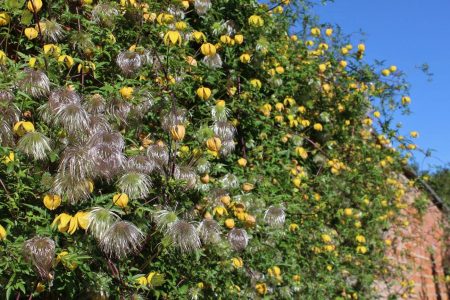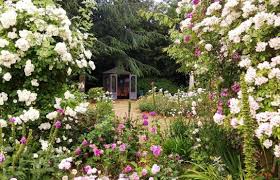Hints and Tips
How to Grow Clematis
The most colourful of all climbing plants are Clematis. They give a delightful extra dimension to the garden and with a good selection of different varieties can provide colour throughout the summer.
They are easy to grow if you have the right conditions and prepare the ground well. Clematis dislike a waterlogged soil, so make sure drainage is adequate, particularly if planting in a pot, and take care not to overwater. Remember the golden rule “Feet in the Shade, Heads in the Sun”, meaning the roots enjoy shade, and the stem and foliage need sun. Clematis require a support of some sort, and a common mistake is to plant too close to a fence, wall or tree, so be sure to leave a minimum of 12” distance. If growing up an obelisk then you can plant directly against it.
Planting Tips
When planting dig the planting hole much bigger and deeper than the size of the flower pot; 18” diameter and depth is ideal. Break up the soil in the bottom of the planting hole and add compost. The best compost for clematis is John Innes No.3. Sprinkle a good handful of Bonemeal into the hole and mix into the loosened soil. Add a scoop of Rootgrow and sprinkle at the bottom of the planting hole (don’t mix it in). Remove the pot the place the plant carefully in the hole making sure that the top of the root ball is buried about 3” (8cm) deeper than it was in its pot and re-fill the hole with a mixture of soil and compost, firming down well. Lean the cane towards the support.
You can also plant clematis in a pot, which needs to be at least 20”deep and with good drainage holes. If growing in a pot you may need to provide additional shading for the roots, and remember not to over-water, particularly in winter.
Provide Shade
Clematis planted by a wall, fence, tree or shrub, may need regular watering especially in its first year but be careful not to overdo it if planting in the autumn.
If your clematis is planted in a hot position, where the base of the plant will be baked by the sun for a large part of the day, place bark chippings or mulch around the base to provide shade for the root system. This will help to keep the roots cool and moist, avoiding the plant drying out so quickly.
Choose your clematis with care
Choose your variety with care – montana types are early summer flowering and very vigorous. These are suitable for covering large expanses, such as house walls. The macropetala and alpine types flower in spring and are good for scrambling through summer flowering shrubs or climbing roses. The texensis and viticella varieties are later flowering and look good growing up an obelisk or trellis. My favourite of all is Clematis texensis “Princess of Wales” which has slender rich pinky-red flowers, but the popular variety “Nelly Moser” also takes some beating.
I’d strongly advise keeping the label of the clematis once it is planted, as this will remind you of it’s pruning requirements. Some need cutting down to about 18” each year, and some are best left alone, with just a bit of tidying up. The label will tell you the precise instructions for the variety you have purchased.
We currently have a good selection of clematis and other climbing plants in stock.
New Stock arriving at Woodside
Winter may have just crept back again this week, but here at Woodside it’s spring all the way! We’ve just taken delivery of our first potted roses of the year, and we’re delighted to introduce a range of Peter Beale’s Roses (World leaders in Classic Roses).
Here’s what Peter Beales Roses have to say about themselves –
“Since 1968, Peter Beales Roses have grown millions of roses, from shrub, climbing to modern hybrid and floribunda roses that are now growing all over the world, from small city gardens in London to hundreds of acres in Japan. All roses and plants are lovingly cared for by hand by our East Anglian based rosarians over two years before they are sold.
Many growers of roses, outsource the growing of their roses to Eastern Europe, or keep their roses in cold store late into the spring and early summer – both practises, we believe, lead to inferior roses and disappointing results. Peter Beales’ roses are all grown in East Anglia tended for by local, expert nurserymen with many years’ experience.”
We are very pleased to be stocking the following roses from the range: Sandringham, St Ethelburga (pictured), Countess of Wessex, Evelyn May (pictured), Raymond Carver, Grosvenor House (pictured), McMillan Nurse, Dunholm Massey and Churchill Rose (pictured).
Experience has taught us that although the David Austin Roses are stunning, they don’t always do so well in our cold Northern climate. Because Peter Beale’s don’t use the practice of cold storage, we have found that they do much better in this area. So, if you’ve previously tried and failed to grow Classic English roses, this could be the year to try again!
We also have lots of other roses available now, including the popular varieties English Miss, Peace, Margaret Merrill, Buff Beauty, Iceberg Climbing and American Pillar which can be seen gloriously adorning the swags in the walled garden of Floors Castle each July.
Pop into Woodside to see our full range of roses. We’re open every day 10am – 5pm.
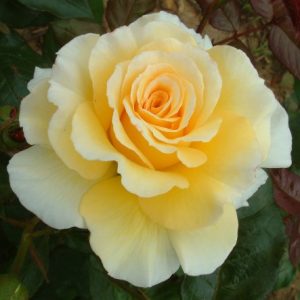
Rose Grosvenor House
A richly fragrant hybrid tea style rose in a rich honey colour fading to creamy white at the edge of the petal.
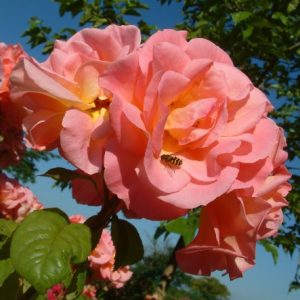
Rose Evelyn May Named after Peter Beale’s mother, this rose produces scented blooms in shades of peach and salmon.
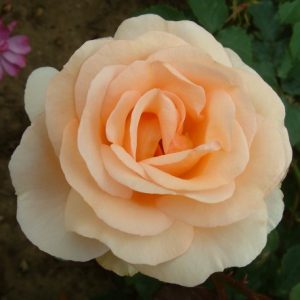
The Churchill Rose
A repeat flowering rose with a lovely perfume to it’s soft apricot blooms, with good disease resistance, so suitable for organic growing.
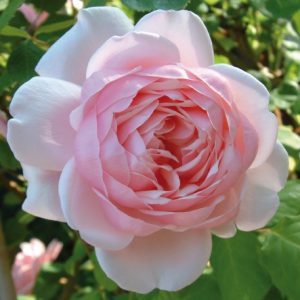
Rose St Ethelburga
Often regarded as a superior choice to the popular Gertrude Jekyll, this rose has an old fashioned, classic appearance, with scented flowers of soft pink.
Hints and Tips for Feeding the Birds
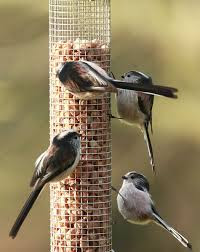 In winter weather all birds need to eat around 40% of their body weight every day. They need as many calories as possible, so feed with the highest calorie foods possible.
In winter weather all birds need to eat around 40% of their body weight every day. They need as many calories as possible, so feed with the highest calorie foods possible.
-
- The best food is sunflower seeds, either as hearts or as seed with the husks. They are quickly digested and converted into energy. Suet pellets, suet blocks and fat balls are also of the highest fat content. Peanuts are also good, but are not as efficient at converting into energy as the other choices.
- Peanuts can go “off” quickly when outside, so only put out a weeks supply at a time.
- Seed can be given all year round. We use the Feeder Seed in all our tube feeders as this attracts a good variety of birds, but remember to give high calorie foods as an extra in bad weather
- Not all birds can perch on the hanging feeders, so don’t forget to provide food for the ground feeders such as blackbirds and robins. A table seed is ideal.
- Avoid giving bread – not only does it attract vermin, but it has little or no nutritional content for the birds. Birds can actually starve to death eating bread as it fills them up and makes them too lethargic to go hunting for nutritional foods.
- Feed the birds as early in the day as possible – remember they have been huddling all night against the cold and they need a boost as early as possible to give them the energy to forage for more food.
- Feed the birds all year round as they depend on us to compensate for habitat loss. Avoid feeding whole peanuts in the Spring as fledglings can easily choke to death on them.
Here at Woodside we stock a large range of CJ Wildlife products in the shop and a good choice of feeding accessories for all gardens.
New Range of Bird Feeders
The design of bird feeders has remained unchanged for decades…..until now! We are really pleased to be offering for sale a brand new range of bird feeders from Europe made from recycled plastic and in several modern designs.
Many of them come with a velcro type band so they can easily be attached to tree trunks or even drainpipes. They all come boxed and are light weight, so ideal for posting off as Christmas presents. I would imagine they would appeal to people in more contemporary style homes, and younger people wanting a “funkier” look. Prices start at just £2.99 for a small fat ball feeder, so they are a great price too!
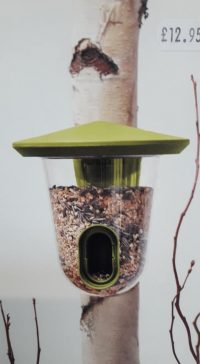
This seed feeder will fasten to a tree trunk or drain pipe
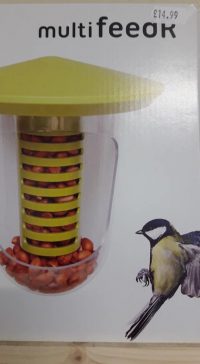
This feeder has two inserts – one for seed and one for nuts
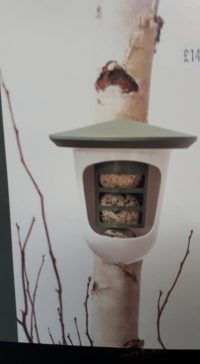
This fat ball feeder comes with a velcro style fastening, so is easy to fix in place
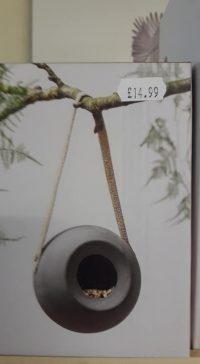
Any type of feed can be put in this hanging feeder

